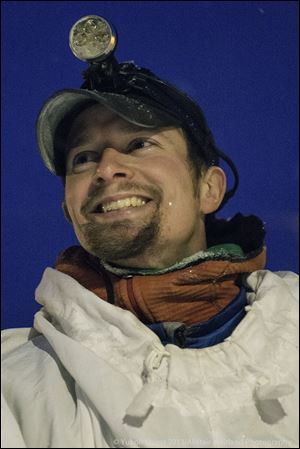
OUTDOORS
Failor finds doggone good life in Alaska
3/2/2014

It is truly amazing where a degree in fine arts from Ohio State University might take you. Possibly to the day when one of your paintings is on display at the National Gallery of Art in Washington or your photography gets featured in an exhibit at a studio in Lower Manhattan’s tony SoHo district.
Or you could be scooping the dog yard in Willow, Alaska, and preparing for a jarring, bone-numbing, thousand-mile ride across the frozen wilderness with 16 of your closest four-legged friends. That’s where 2007 OSU graduate Matt Failor was a few days ago, ready for his third run in the Iditarod Trail Sled Dog Race.
“I’m racing sled dogs for a living — how many people can say that,” Failor said last week as he packed for the ceremonial start of the race, which took place yesterday in Anchorage. “When I left Ohio State, I had no idea this is where I would be in 2014.”
Failor, whose connection to the Toledo area is deep, since his mother graduated from Notre Dame Academy and his dad graduated from Rossford High School, spent some of his college summers working at the Mendenhall Glacier near Juneau. But he didn’t go through an Alaskan winter until 2008, when he worked as a trainer and dog handler for an Iditarod musher. That experience gave him a taste of the unique relationship sled dogs have with their musher and also exposed him to the allure of the race, the ultimate in outdoors adventure.
“That connection with the dogs is really hard for people to truly understand,” he said. “You spend so much time with them.”
In his first Iditarod in 2012, Failor made his baptismal run with a group of young, inexperienced dogs that belonged to another musher. “I ran a very conservative schedule and I was not really competing in the event. At that point, the team and I both had a lot to learn.”
After finishing 47th as a rookie, Failor was 28th last year in a field of 66 mushers. In the current race, he expects to be in the thick of the contenders.

Matt Failor, an Ohio State grad whose parents are natives of the Toledo area, is competing in the historic Iditarod Trail Sled Dog Race for the third time.
“I’ve been through this thing twice now, and I plan to do even better. I’m looking to fine-tune everything,” Failor said. “Plus, these are my dogs now. I raised some of them from pups.”
Failor moved to Willow, a tiny berg up the highway north of Anchorage, and lives in a small cabin there on a half-acre plot, with his 20 dogs. Failor hopes to add electricity and running water at some point, but for now, all of his efforts and his funds are put back into the dogs.
“Whatever I have, if it’s not going to feed the dogs and care for the dogs, then it goes to buy something for the dogs,” he said. “In this kind of racing, the two-legged guy is just the one in charge — he’s the coach — but without that tight bond with the team, you will never win. That’s why all of the champions live with their dogs.”
Failor’s calendar consists of two main elements — saving for the Iditarod, and training for the Iditarod. In May, he and the 20 dogs make the thousand-mile drive to Juneau to work his summer job, telling tourists about the history of the sport, displaying his sled and gear, and giving customers a test ride on a cart pulled by his team.
Failor and seven fellow employees and their 90 dogs share quarters there through September.

Failor
“The summers are just as demanding, since I’m still caring for the dogs, and talking sled dogs six days a week,” said Failor. “But every dollar I make in the summer goes to the dogs. The connection with them is second to none, and I wish other people could feel that. Working with the dogs, and seeing how hard they work to please you, it really puts a smile on my face.”
When the tourist season ends, Failor is back in Willow by October 1 to prep for the race. He started the team with an easy three-mile training run that day, and by about 10 days ago had logged 2,000 miles on the trails, building their stamina for the race, where they could encounter temperatures of minus-40 and 100 mile-per-hour winds. Failor and his team put in an “easy” 70-mile run to end their training schedule.
Racing sled dogs is expensive — the Iditarod carries a $3,000 entry fee — but Failor has gained some sponsorship money to help with the costs. A helicopter company based in Juneau, a custom knife maker from Ohio, and the Anchorage Snow Dawgs chapter of the Cleveland Browns Backers are among the Failor supporters.
“Having sponsors is a big deal. I wouldn’t be able to do this without sponsors,” said Failor.
The first place prize money in the Iditarod varies, with last year's winner receiving $50,400 and a new Dodge truck. The victory is worth much more in potential endorsement money.
Entering this year’s race, the 31-year-old Failor said his biggest concern is the risk of sleeping through his alarm after the days of constant cold and fatigue start to wear on him.

“It is a terribly demanding race, but crossing the finish line is very rewarding,” he said. “I’m like a dog; I have a short memory, so I forget about the struggles and the hardship, and I’ve always liked competition. Plus, seeing the dogs work so hard is great. Their desire to please the musher is endless.”
Failor said he is grateful for the strong following he has back home in Ohio, where the Internet has allowed his extended family and friends to follow the Iditarod and track his progress in his previous runs. But when the race ends, it will be back to Willow, back in the small cabin, and living the austere life with the dogs that is Failor’s version of paradise.
“This race is a 10-day event for the people back home, but for me, it’s my life. It’s the Super Bowl, and if you want to win, you can’t stop thinking about it or working on it,” he said. “Plus it’s fun to say this is my job. I get to race the Iditarod for a living — how cool is that.”
Contact Blade outdoors editor Matt Markey at: mmarkey@theblade.com or 419-724-6068.